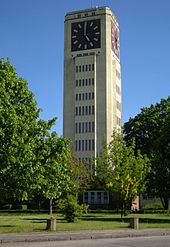Wittenberge sewing machine factory
| Wittenberge sewing machine factory | |
|---|---|
| legal form | AG , VEB and GmbH |
| founding | 1903 |
| resolution | January 31, 1992 |
| Reason for dissolution | Liquidation by the Treuhandanstalt |
| Seat | Wittenberge , Germany |
| Number of employees | maximum 3200 in the 1980s |
| Branch | Mechanical engineering , textile industry |
| Website | naehmaschinenwerk.de |
The Wittenberge sewing machine factory was a factory in Wittenberge that existed from 1903 until it was liquidated by the Treuhandanstalt on January 31, 1992 after German reunification . During the GDR times, the company was a state-owned company (VEB) and was called VEB Sewing Machine Works Wittenberge . Before the GDR was founded , the sewing machines produced were called Singer , then the new developments came on the market under the names Veritas and Naumann .
history

The plant was put into operation in 1904 as a branch of the American Singer Company : It earned Wittenberge the title “City of Sewing Machines”. In 1926 the Singer Turn- und Sportverein e. V. founded. The later trademark Veritas (Lat., German truth ) can still be found in the name of the sports club CM Veritas Wittenberge and in the VERITASKLUB .
From 1928 the clock tower of the plant was built in a 14-month construction period : the second largest free-standing clock tower in Europe, the largest free-standing clock tower in Germany.
From 1931 the world economic crisis also affected this company, the weekly working time was reduced from 48 to 40 hours on June 1st. This year 43,351 sewing machines were exported. There were numerous strikes in 1932; however, the business recovered, so that an extension could be inaugurated in 1936. Managerial changes were made with the use of Hollerith - punch-card devices for machine control.
From 15 June 1945, the plant was as reparations to the year 1946 into disassembled and after his seizure in foundry and machine factory Wittenberge renamed. In the same year a new foundry could be put into operation with credits , the workforce increased to 382 people. On January 1, 1965, the factory was merged with the subcontractors in Lenzen and Bad Wilsnack , which were incorporated in 1964, to form the VEB sewing machine factory in Wittenberge - TEXTIMA combine. In 1968 the one millionth household sewing machine was exported. In 1970 the industrial machine production was outsourced and the company changed its name again to Kombinat VEB sewing machine works Wittenberge ; he manufactured at seven locations. The great demand at home and abroad made another new plant necessary, which was built in Wittenberge from 1976 to 1980. In 1983 the foundry was automated. In 1989 the VEB sewing machine factory in Wittenberge employed around 3,200 workers. The seven millionth household sewing machine was produced on October 4th of that year.
After German reunification, the factory was liquidated on January 31, 1992 by the Treuhandanstalt. According to the then member of the plant management Henry Strutz to the Märkische Allgemeine in May 2013, the following reasons were decisive: "No company in the industry wanted or could buy us, because some of them were already in financial difficulties themselves", says Strutz. Secondly, the monetary union presented the Veritaswerk with an “insurmountable hurdle” because the prices that had been changed in a ratio of one to two were too much for the company financially. Ultimately, the traditional sales markets also collapsed, so that at least at that time there was no longer any need for sewing machines from Wittenberge.
Most of the buildings have been vacant since the plant was closed. In the former administration building there is an upper school center for the Prignitz district.
architecture
The former sewing machine factory consists of at least eight larger complex buildings, mostly built in the north German brick style or in reinforced concrete, the shapes are neoclassical . It is noteworthy that all dimensions are based on the American parent company in inches .
Persons affiliated with the company
Products (selection)
- Veritas 8017 : First free-arm sewing machine from the GDR with a plastic housing (designed in 1960 by Klaus Kunis)
- Household knitting machine VERITAS model 5443 (1974)
- Free arm sewing machine Columba NP 4500 (1983–1990)
- Free arm sewing machine Famula 4681 (1986–1991)
- Rubina 1462 (1989-1991)
literature
- Singer-Werkfreund : company newspaper of Singer sewing machines AG, factory Wittenberge
- Communications from the Singer Comradeship . Supplement to the Singer-Werkfreund.
- Sewing machine works Wittenberge : 10-volume book edition (publisher VERITASKLUB e.K. , self-published, editions 2005–2014)
Web links
- naehmaschinenwerk.de : VERITASKLUB e. K.
- Company film studio "VERITAS" - And it works , 18:19 minutes
- Textima promotional video from the 1970s , 10:07 minutes
- Sewing machine factory at the end of 1991, on YouTube, part 1 , 23:44 minutes
- Sewing machine factory at the end of 1991, on YouTube, part 2 , 21:56 minutes
Individual evidence
- ↑ How the arable town of Wittenberge developed into an industrial town: The important stage in the town's history from the 19th century to around the middle of the 20th century. available at: books.google.de , p. 89.
- ↑ Operating history of the sewing machine factory on naehmaschinenwerk.de
- ↑ 15 files full of Veritas history , Märkische Allgemeine, May 15, 2013, accessed on February 21, 2017
- ^ Günther Höhne : Veritas series 8017 and the rebirth of a legend. On: ddr-museum.de from September 1, 2016
Coordinates: 52 ° 59 ′ 27.9 ″ N , 11 ° 46 ′ 6.1 ″ E



